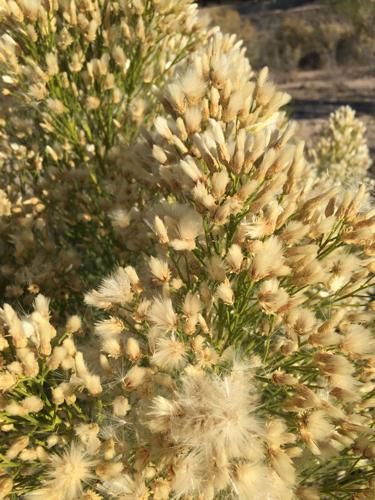Question: I occasionally run across a dead branch on some of my mesquite trees. The dead branch sticks out like a sore thumb, and on closer inspection, there is a ring around the branch etched into the bark. The foliage in front of the ring is dead, but behind everything appears fine. First, do you know what causes this? Second, should I be concerned. And third, should I be preventing this and how? Right now, all I do is prune the branch out.
Answer: The ring etched in the bark is the work of the mesquite twig girdler (Oncideres rhodosticta). This beetle is in the family Cerambycidae that are commonly referred to as long-horned beetles due to their long antennae. The adults aren’t commonly seen on the trees although they are attracted to lights at night if you want to find them. The female chews a ring in the stem and deposits her eggs further out on the stem. The eggs hatch in the stem and the larvae feed on the dying wood in the stem caused by the girdle cutting off nutrients to the end of the branch. The larvae will overwinter in the wood and adults will emerge in the spring. Research has shown the damage has no affect on the health of mesquite trees and it is simply nature’s way of pruning. So the good news is you don’t have to do anything to prevent these beetles from chewing on your trees.
Question: I have a desert broom plant in my yard that has turned into a tree. I really like it but it is now blooming and is sending cottony stuff all over the yard. My neighbor said it is a weed and a nuisance and I should cut it down. Is there any way I can keep it from blooming?
Answer: Desert broom (Baccharis sarothroides) is a native plant and very common in the Southwest. It is often considered a weed because of its ability to colonize open spaces quickly. My predecessor at the University of Arizona Cooperative Extension, George Brookbank, was a proponent of this plant as a good native shrub for landscape use, so not everyone sees this plant as a weed. There is no way to prevent it from blooming, but you could prune off the flowers before they go to seed and start taking flight. That way you could still enjoy the plant to some extent and hopefully appease your neighbor.
Question: Our HOA has declared war on buffelgrass: a good thing. But rather than remove it, they are having intense commercial spraying of glyphosate using concentrations higher than the typical herbicide available to homeowners. I cannot find information (from scientific sources such as .edu) about the immediate or long-term toxicity of the spray on cactus or our desert trees. Do you know of any research showing what it may do?
Answer: According to our University of Arizona Cooperative Extension Weed Specialist, Bill McCloskey, direct spraying of cacti with glyphosate repeatedly will probably kill most cactus species but they can withstand incidental spray contact (i.e., the whole plant is not sprayed) intermittently and can survive a single direct spraying. Generally, we recommend spraying grass-specific herbicides for grass control (e.g., fluaziflop, sethoxydim or clethodim on bermuda grass) to avoid injuring the cacti. Unfortunately, this class of herbicides doesn’t work well on buffelgrass, but maybe repeated spraying would eventually do it. Manual removal of buffelgrass would be effective in this case but understandably hard around cacti.
Question: I found this insect on my gas grill today. Is this the kissing bug I have been reading about?
Answer: What you are seeing is the giant agave bug (Acanthocephala thomasi). Kissing bugs (Triatoma species) are smaller and don’t have the bright orange feet and orange tips on the antennae. Also, the kissing bugs feed primarily on mammals, such as pack rats and humans, whereas the bug you found feeds on plants. Recently, there was a flurry of news reports in other parts of the country on the kissing bugs and the associated Chagas disease they can transmit. These stories then spread through social media, gathering some misinformation as they went. So I understand why you are concerned. Despite the media hype, this was not actually new information.
Kissing bugs are more common in the Southwest. However, the risk of Chagas disease transmission in Arizona is very low, according to University of Arizona Cooperative Extension Specialist Dawn Gouge. UA researchers found a high rate of infection (about 40 percent) of kissing bugs in southern Arizona by the protozoan Trypanosoma cruzi that causes the Chagas disease infection. However, the kissing bugs in Arizona differ from those in areas where Chagas disease is a health problem and are not as effective in transmitting the disease to humans. The reason has to do with the timing of blood feeding and defecating. Our local species fly then poop as opposed to poop then fly. The protozoa are passed in feces, not during blood feeding, so by waiting to defecate until after they fly from where they eat, their behavior greatly reduces chances for transmission.






